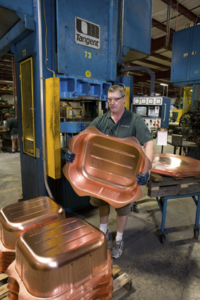Deep Draw Stampings: The Basics You Need to Know
Deep draw stamping is an essential manufacturing process that plays a critical role in producing metal components for industries ranging from automotive and aerospace to consumer goods and electronics. It’s a technique known for its precision, efficiency, and versatility. The following is a basic breakdown of deep draw stampings, from what they are to how they’re made and where they’re used.
What Are Deep Draw Stampings?
Deep draw stampings are metal parts created through a process called deep drawing. This involves forming a flat metal blank into a desired three-dimensional shape using a series of dies and punches. The term “deep draw” refers to the depth of the shape being greater than its width, achieved by drawing the metal into a die cavity.
Deep draw stampings are known for their seamless construction, which makes them particularly strong and durable. Common examples include cylindrical containers, enclosures, and other components that require precision and structural integrity.
The Deep Draw Stamping Process
Here’s a step-by-step overview of how deep draw stampings are made:
- Material Selection and Blank Preparation
The process starts with selecting the right type of metal and cutting it into flat blanks. The material must have sufficient ductility to withstand deformation without cracking. - Initial Drawing Operation
The metal blank is placed over a die cavity, and a punch applies force to push the blank into the cavity. This creates the basic shape of the component. - Progressive Drawing
For more complex or deeper shapes, the part undergoes additional drawing operations. Each step further refines the shape while maintaining precise dimensions. - Trimming and Secondary Operations
Excess material is trimmed, and additional processes like cleaning, deburring, or coating are performed to ensure the final product meets exact specifications. - Inspection and Quality Control
Every part undergoes rigorous inspection to ensure it meets the required tolerances and quality standards.
Materials Used in Deep Draw Stampings
Deep draw stamping works with a variety of metals, each chosen based on the specific application. Common materials include:
- Aluminum: Lightweight and corrosion-resistant, ideal for aerospace and automotive parts.
- Stainless Steel: Known for its strength and corrosion resistance, often used in food, medical, and industrial applications.
- Copper and Brass: Excellent for electrical and decorative purposes due to their conductivity and aesthetic appeal.
- Cold-Rolled Steel: Cost-effective and commonly used in durable industrial applications.
Benefits of Deep Draw Stampings
Deep draw stamping offers several advantages over other metal-forming techniques:
- Seamless Construction
Unlike welding or assembly methods, deep draw stampings produce one-piece parts with no seams, making them stronger and more durable. - Cost-Effective for High Volumes
While initial tooling costs may be higher, deep draw stamping is highly efficient for large production runs, reducing per-part costs. - High Precision
The process ensures tight tolerances, resulting in parts with consistent quality and dimensions. - Material Efficiency
Deep drawing minimizes waste by using most of the blank material in the final part. - Versatility
This method can produce complex shapes and designs suitable for a wide range of industries.
Applications of Deep Draw Stampings
Deep draw stampings are found in many everyday products and specialized industrial components. Common applications include:
- Aerospace: Fuel tanks, instrument housings, and satellite components.
- Automotive: Brake housings, oil pans, and exhaust system components.
- Medical Devices: Surgical instruments, battery enclosures, and sterile containers.
- Consumer Products: Cookware, beverage cans, and kitchen sinks.
- Electronics: Shielding enclosures, connector shells, and battery cases.
Challenges in Deep Draw Stamping
While deep draw stamping offers numerous benefits, it does come with challenges:
- Tooling Costs: The initial investment in dies and punches can be significant.
- Material Limitations: Not all metals are suitable for deep drawing due to potential cracking or wrinkling.
- Complexity of Shapes: Highly intricate designs may require advanced tooling and expertise.
Deep draw stampings are a cornerstone of modern manufacturing, offering a blend of durability, precision, and efficiency. By understanding the basics of this process, businesses can better leverage its benefits for their production needs. Whether you’re manufacturing components for aerospace, automotive, or consumer goods, deep draw stamping provides a reliable and versatile solution.
Ready to explore how deep draw stamping can work for your projects? Reach out to learn more about the process and how it can be customized for your specific needs.

